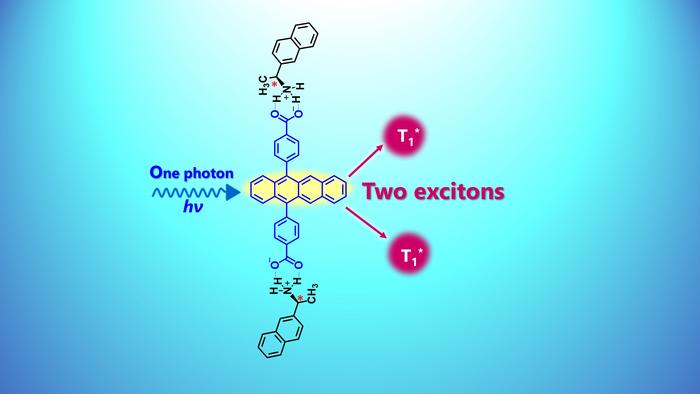Summary: Scientists at Kyushu University have discovered a new way to enhance energy production in solar cells using a process called singlet fission. By introducing chirality – molecular structures that mirror each other – into light-absorbing molecules, they achieved a remarkable 133% quantum yield. This breakthrough could help push solar cell efficiency beyond current theoretical limits.
Journal: Advanced Science, 2024, DOI: 10.1002/advs.202405864
Reading time: 4 minutes
A New Path to Better Solar Cells
Imagine being able to create two particles of energy from a single particle of light. This isn’t science fiction – it’s a process called singlet fission, and researchers at Kyushu University have just made it more efficient than ever before. Their groundbreaking research could help break through current solar cell efficiency limitations.
Professor Nobuo Kimizuka and his team at Kyushu University have demonstrated a novel way to enhance this energy-multiplying process by using molecular structures that mirror each other, much like your left and right hands. These “chiral” structures, when properly arranged, can significantly boost the efficiency of singlet fission.
Breaking the Efficiency Barrier
Current solar cells face a fundamental limitation known as the Shockley-Queisser limit, which caps their efficiency at about 32%. However, singlet fission technology could theoretically push this boundary to approximately 45%, representing a massive leap forward in solar energy production.
The research team achieved a remarkable 133% quantum yield through their innovative approach. As Professor Kimizuka explains: “We have discovered a novel method to enhance SF by achieving chiral molecular orientation of chromophores in self-assembled structures.”
How It Works
The team created special nanoparticles in water using molecules called tetracene dicarboxylic acid combined with various chiral amines. These nanoparticles self-assemble into structures that can effectively split single light particles (photons) into two separate energy carriers.
This process occurs at an incredibly fast rate – specifically, 6.99 × 109 per second. What makes this discovery particularly exciting is that when the team tested similar particles without the chiral structure, they didn’t observe any singlet fission at all.
Technical Terms Glossary
Singlet Fission: A process where one light particle (photon) generates two excited states, effectively doubling the potential energy production.
Chirality: A property of molecules that makes them impossible to superimpose on their mirror image, similar to how left and right hands are mirror images but cannot be superimposed.
Quantum Yield: A measure of the efficiency of a photochemical process, showing how many products are generated per photon absorbed.
Chromophores: Molecules that can absorb specific wavelengths of light.
Test Your Knowledge
1. What is the current theoretical efficiency limit for single junction solar cells?
Answer: 32% (The Shockley-Queisser limit)
2. What quantum yield did the researchers achieve with their chiral nanoparticles?
Answer: 133%
3. What type of molecular structure was key to achieving efficient singlet fission?
Answer: Chiral structures (molecules that mirror each other)
4. Who led this research at Kyushu University?
Answer: Professor Nobuo Kimizuka
Enjoy this story? Get our newsletter! https://scienceblog.substack.com/
If our reporting has informed or inspired you, please consider making a donation. Every contribution, no matter the size, empowers us to continue delivering accurate, engaging, and trustworthy science and medical news. Independent journalism requires time, effort, and resources—your support ensures we can keep uncovering the stories that matter most to you.
Join us in making knowledge accessible and impactful. Thank you for standing with us!

